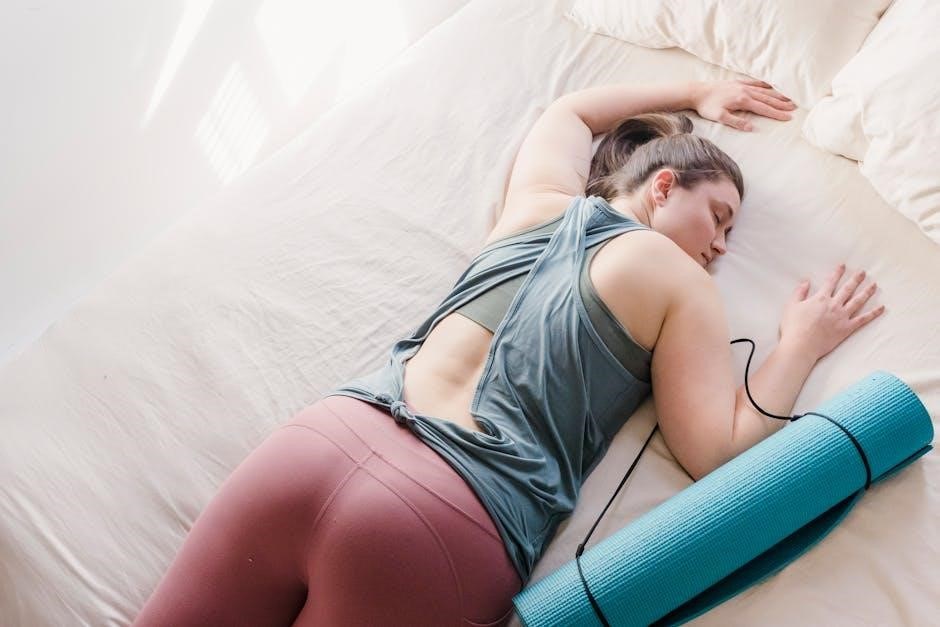sleep apnea exercises pdf

Sleep apnea is a condition causing repeated breathing pauses during sleep, often leading to disrupted rest and health issues. Exercises, such as myofunctional therapy and nasal breathing practices, can help strengthen throat and tongue muscles, improving airway stability and reducing symptoms. These non-invasive strategies complement traditional treatments, offering a convenient and effective way to manage sleep apnea from home. Regular practice can enhance sleep quality and overall well-being for those affected by this condition.
Understanding Sleep Apnea and Its Types
Sleep apnea is a sleep disorder characterized by repeated pauses in breathing during sleep, lasting at least 10 seconds. These pauses, known as apneas, disrupt sleep quality and reduce oxygen levels in the blood. There are two main types: obstructive sleep apnea (OSA), caused by a blocked airway due to relaxed throat muscles or physical obstructions, and central sleep apnea (CSA), resulting from the brain failing to send proper breathing signals. OSA is the most common form and can lead to loud snoring and daytime fatigue. Proper diagnosis is essential for effective management.
Benefits of Exercises for Managing Sleep Apnea
Exercises for sleep apnea offer a non-invasive approach to improving symptoms by strengthening the muscles of the tongue, throat, and upper airway. These practices enhance airway stability, reducing the likelihood of collapse during sleep. Regular exercise can also improve nasal breathing, promote better sleep quality, and decrease snoring. Additionally, strengthening these muscles may reduce the severity of apneas, making it easier to manage the condition without reliance on devices like CPAP machines. Consistent practice can lead to long-term improvements in both sleep quality and overall well-being.

Myofunctional Therapy for Sleep Apnea
Myofunctional therapy targets the muscles of the tongue, throat, and upper airway to improve their strength and coordination, reducing sleep apnea severity. It is a non-invasive, home-based approach.
What is Myofunctional Therapy?
Myofunctional therapy is a non-invasive approach focusing on strengthening and improving the coordination of tongue, throat, and upper airway muscles. It aims to enhance airway stability, particularly during sleep, to reduce sleep apnea symptoms. Through targeted exercises like tongue slides, stretches, and swallowing techniques, this therapy helps improve breathing patterns and muscle tone. Regular practice can lead to better airway patency, reducing snoring and apnea events. It is often recommended as a complementary treatment to traditional therapies, offering a convenient and effective way to manage sleep apnea from home.
Exercises to Strengthen Tongue and Throat Muscles
Targeted exercises can significantly strengthen the tongue and throat muscles, improving airway stability during sleep. One effective exercise is the tongue press, where you press your tongue firmly against the roof of your mouth and hold for 5 seconds. Another is the yawn exercise, which involves opening your mouth wide and stretching your throat muscles. Additionally, chewing exercises simulate eating motions without food, enhancing muscle tone. Regular practice of these exercises can help reduce sleep apnea symptoms by improving muscle strength and coordination in the upper airway.

Tongue Exercises for Sleep Apnea
Tongue exercises, like sticking your tongue out or pressing it against the roof of your mouth, strengthen muscles and improve airway stability during sleep.
Simple Tongue Exercises to Improve Airway Stability
Simple tongue exercises can significantly improve airway stability, reducing sleep apnea symptoms. Start with sticking your tongue out as far as possible and holding for 5-10 seconds. Repeat 5-10 times. Another exercise involves pressing your tongue firmly against the roof of your mouth, holding for 5 seconds, and releasing. Perform this 10 times. Additionally, slide your tongue from side to side behind your teeth, repeating 10 times on each side. These exercises strengthen tongue muscles and enhance airway patency during sleep, promoting better breathing and restful nights.
Advanced Tongue Workouts for Better Sleep
Advanced tongue exercises can further enhance airway stability and reduce sleep apnea severity. Try the “tongue-to-cheek” resistance exercise: press your tongue against the inside of your cheek while gently pushing outward with your finger. Hold for 5 seconds, repeat 10 times per side. Another advanced workout involves lifting the back of your tongue to touch the soft palate while inhaling, then releasing while exhaling. Perform this 10 times. These exercises strengthen upper airway muscles, improving breathing patterns and promoting uninterrupted sleep. Consistency is key for long-term benefits.
Nasal Breathing Exercises
Nasal breathing exercises help stabilize the upper airway, improving sleep quality and reducing sleep apnea symptoms. Practices like diaphragmatic breathing and nostril exercises enhance airway resistance and promote consistent airflow, aiding uninterrupted sleep and overall well-being.
Importance of Nasal Breathing for Sleep Quality
Nasal breathing is crucial for maintaining upper airway stability during sleep, reducing sleep apnea symptoms. It promotes diaphragmatic breathing, increasing oxygen levels and carbon dioxide balance, which enhances sleep depth. Nasal resistance strengthens the airway, preventing collapse and improving airflow. Regular nasal breathing exercises can reduce mouth breathing, a common contributor to airway obstruction. By prioritizing nasal breathing, individuals can achieve better sleep quality, reducing disruptions and promoting overall well-being. This practice is a cornerstone of non-invasive sleep apnea management strategies.

Practices to Enhance Nasal Breathing
Practices like diaphragmatic breathing and nasal strip exercises can improve nasal airflow, reducing sleep apnea symptoms. Regularly practicing nasal congestion relief techniques, such as saline sprays or steam inhalation, can clear airways. Tongue exercises that promote proper nasal breathing alignment are also beneficial. Consistent practice strengthens nasal muscles, enhancing breathing stability during sleep. These techniques, often detailed in sleep apnea exercise guides, provide a natural, non-invasive approach to improving sleep quality and reducing airway obstruction.

Sample Exercise Routine for Sleep Apnea
A daily routine includes tongue slides, nasal breathing drills, and throat muscle exercises. Perform these 20 minutes before bed to strengthen airway muscles and improve sleep quality.
Daily Exercises to Perform Before Bedtime
Start with tongue slides: stick your tongue out as far as possible, then slide it back slowly. Repeat 10 times. Next, practice nasal breathing by inhaling deeply through your nose for 5 seconds, hold for 5 seconds, and exhale through your mouth for 5 seconds. Do this 5 times. Perform cheek exercises by pushing your finger against your cheek and resisting with your muscles for 5 seconds on each side. End with neck stretches to relax and strengthen throat muscles. Consistency is key for improving airway stability and reducing sleep apnea symptoms.
Tracking Progress and Adjusting the Routine
Keep a journal to track your daily exercise routine and note improvements in breathing, sleep quality, or symptom reduction. Monitor how easily you can perform exercises like tongue slides or nasal breathing. As you progress, gradually increase the number of repetitions or intensity. If symptoms persist, consult your healthcare provider to adjust the routine. Consistency is key, and tailoring the exercises to your needs ensures long-term benefits. Regular follow-ups with a specialist can also help refine your approach for better results.
The Role of Diet and Lifestyle in Managing Sleep Apnea
Diet and lifestyle play a crucial role in managing sleep apnea. Weight management and avoiding alcohol/sedatives help reduce symptoms. Healthy choices support overall treatment effectiveness and sleep quality.
How Diet Impacts Sleep Apnea Symptoms
Diet plays a significant role in managing sleep apnea symptoms. Weight management through a healthy diet can reduce fat around the airways, improving breathing. Avoiding inflammatory foods and alcohol, which relax throat muscles, can minimize airway obstruction. Eating smaller, balanced meals and avoiding heavy meals before bedtime can also reduce symptoms. Incorporating anti-inflammatory foods and staying hydrated supports overall respiratory health. A tailored diet plan, combined with exercise, can significantly enhance sleep quality and alleviate sleep apnea severity.
Lifestyle Changes to Complement Exercise Therapy
Adopting healthy lifestyle habits can significantly improve sleep apnea management. Maintaining a healthy weight through balanced nutrition reduces airway obstruction. Avoiding alcohol and sedatives, which relax throat muscles, helps prevent airway collapse. Quitting smoking decreases airway inflammation, while stress-reducing activities like meditation improve sleep quality. Regular exercise, beyond targeted therapies, enhances overall physical health. Additionally, sleeping on your side instead of your back reduces tongue and soft tissue collapse. Consistent sleep schedules and a relaxing bedtime routine further support better sleep and symptom reduction.
Exercises like myofunctional therapy and nasal breathing practices effectively manage sleep apnea by strengthening airway muscles. Consistent practice improves symptoms, enhancing sleep quality and overall health.
Final Thoughts on Using Exercises to Manage Sleep Apnea
Exercises like myofunctional therapy and nasal breathing practices are valuable tools for managing sleep apnea. By strengthening the tongue, throat, and upper airway muscles, these exercises can reduce symptoms and improve sleep quality. Consistency is key, as regular practice yields the best results. While exercises are not a cure, they complement other treatments and offer a non-invasive way to take control of the condition. For personalized plans, consulting a healthcare provider is recommended to ensure the most effective approach.
Resources for Further Reading and Exercise Plans
For those seeking detailed guidance, numerous resources are available online, including downloadable PDF guides and research studies. Websites specializing in sleep health offer comprehensive exercise plans tailored for sleep apnea management. Medical journals and reputable health organizations provide evidence-based information on myofunctional therapy and breathing techniques. Additionally, sleep clinics and specialists often share practical workout routines to enhance airway stability. Exploring these resources can provide a wealth of knowledge and actionable steps to improve sleep quality effectively.




